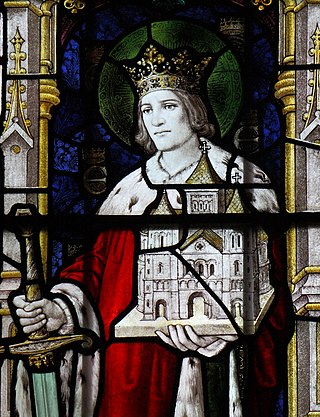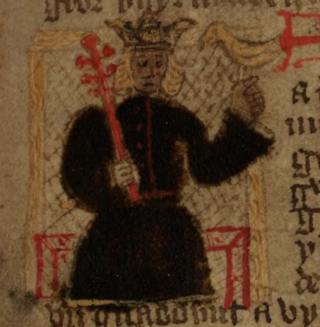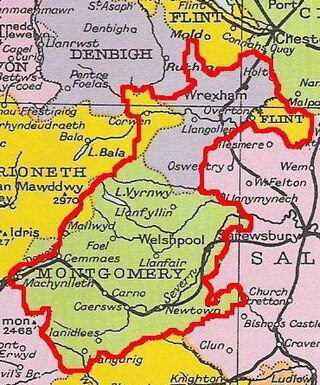Related Research Articles

Year 616 (DCXVI) was a leap year starting on Thursday of the Julian calendar. The denomination 616 for this year has been used since the early medieval period, when the Anno Domini calendar era became the prevalent method in Europe for naming years.

Rhodri ap Merfyn, popularly known as Rhodri the Great, succeeded his father, Merfyn Frych, as King of Gwynedd in 844. Rhodri annexed Powys c. 856 and Seisyllwg c. 871. He is called "King of the Britons" by the Annals of Ulster. In some later histories, he is referred to as "King of Wales", although the title is anachronistic and his realm did not include southern Wales.

The Kingdom of Powys was a Welsh successor state, petty kingdom and principality that emerged during the Middle Ages following the end of Roman rule in Britain. It very roughly covered the northern two-thirds of the modern county of Powys and part of today's English West Midlands. More precisely, and based on the Romano-British tribal lands of the Ordovices in the west and the Cornovii in the east, its boundaries originally extended from the Cambrian Mountains in the west to include the modern West Midlands region of England in the east. The fertile river valleys of the Severn and Tern are found here, and this region is referred to in later Welsh literature as "the Paradise of Powys".

Rhys ap Tewdwr was a king of Deheubarth in Wales and member of the Dinefwr dynasty, a branch descended from Rhodri the Great. He was born in the area which is now Carmarthenshire and died at the battle of Brecon in April 1093.

Bleddyn ap Cynfyn, sometimes spelled Blethyn, was an 11th-century Welsh king. Harold Godwinson and Tostig Godwinson installed him and his brother, Rhiwallon, as the co-rulers of Gwynedd on his father's death in 1063, during their destruction of the kingdom of their half-brother, Gruffydd ap Llywelyn. Bleddyn became king of Powys and co-ruler of the Kingdom of Gwynedd with his brother Rhiwallon from 1063 to 1075. His descendants continued to rule Powys as the House of Mathrafal.
Merfyn Frych, also known as Merfyn ap Gwriad and Merfyn Camwri, was King of Gwynedd from around 825 to 844, the first of its kings known not to have descended from the male line of King Cunedda.

Madog ap Maredudd was the last prince of the entire Kingdom of Powys, Wales and for a time held the Fitzalan Lordship of Oswestry.
Brochwel son of Cyngen, better known as Brochwel Ysgithrog, was a king of Powys in eastern Wales. The unusual epithet Ysgithrog has been translated as "of the canine teeth", "the fanged" or "of the tusk".

Powys Fadog was the northern portion of the former princely realm of Powys, which split in two following the death of Madog ap Maredudd in 1160. The realm was divided under Welsh law, with Madog's nephew Owain Cyfeiliog inheriting the south and his son Gruffydd Maelor I, who inherited the north.

Brycheiniog was an independent kingdom in South Wales in the Early Middle Ages. It often acted as a buffer state between England to the east and the south Welsh kingdom of Deheubarth to the west. It was conquered and pacified by the Normans between 1088 and 1095, though it remained Welsh in character. It was transformed into the Lordship of Brecknock and later formed the southern and larger part of the historic county of Brecknockshire. To its south was the Kingdom of Morgannwg.
Cynan Garwyn was king of Powys in the north-east and east of Wales, who flourished in the second half of the 6th century. Little reliable information exists which can be used to reconstruct the background and career of the historical figure. Available materials include early Welsh poetry, genealogies and hagiography, which are often late and of uncertain value.
Rhain ap Cadwgan was an 8th-century king of Dyfed and Brycheiniog in Wales of the Early Middle Ages. He succeeded his father Cadwgan, who succeeded his father Caten ap Cloten.
Selyf ap Cynan or Selyf Sarffgadau appears in Old Welsh genealogies as an early 7th-century King of Powys, the son of Cynan Garwyn.
Cynddylan, or Cynddylan ap Cyndrwyn was a seventh-century Prince of Powys associated with Pengwern. Cynddylan is attested only in literary sources: unlike many kings from Brittonic post-Roman Britain, he does not appear in the early Welsh genealogies or other historical sources. The son of King Cyndrwyn, Cynddylan is described in the probably seventh-century poem Marwnad Cynddylan and seems to have been a chieftain in Powys.
Eiludd Powys was an early 7th-century King of Powys.

Wales in the High Middle Ages covers the 11th to 13th centuries in Welsh history. Beginning shortly before the Norman invasion of the 1060s and ending with the Conquest of Wales by Edward I between 1278 and 1283, it was a period of significant political, cultural and social change for the country.

Wales in the Middle Ages covers the history of the country that is now called Wales, from the departure of the Romans in the early fifth century, the development of regional Welsh kingdoms and Celtic conflict with the Anglo-Saxons, reducing Celtic territories. Conflict also occurred between the Welsh and the Anglo-Normans from the 11th century until the annexation of Wales into the Kingdom of England in the early sixteenth century.

The Royal House of Mathrafal began as a cadet branch of the Welsh Royal House of Dinefwr, taking their name from Mathrafal Castle, their principal seat and effective capital. They effectively replaced the House of Gwertherion, who had been ruling the Kingdom of Powys since late Roman Britain, through the politically advantageous marriage of an ancestor, Merfyn the Oppressor. His son, King Bleddyn ap Cynfyn, would join the resistance of the Anglo-Saxon King Harold Godwinson, against the invasion of William the Conqueror, following the Norman conquest of England. Thereafter, they would struggle with the Plantagenets and the remaining Welsh Royal houses for the control of Wales. Although their fortunes rose and fell over the generations, they are primarily remembered as Kings of Powys and last native Prince of Wales.